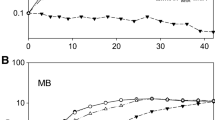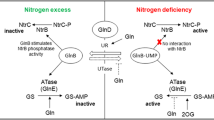Abstract
RamA plays a regulatory role for acetate utilization and S-layer biosynthesis in Corynebacterium glutamicum. Looking for any additional role, the function of RamA was analyzed in Corynebacterium ammoniagenes, which is closely related to C. glutamicum. In this study, we showed that the ΔramA mutant constructed by a markerless knockout strategy possessed increased cell surface hydrophobicity, leading to the formation of aggregated cell masses in liquid media. In addition, the mutant exhibited an elongated cell shape as observed by SEM, suggesting that cell wall-associated proteins might be influenced. Furthermore, cell surface proteome analysis revealed that the expression of cmytA gene encoding corynomycoloyl transferase required for cell wall biosynthesis was down-regulated in the mutant, supporting the regulatory role of RamA in cell wall assembly. These studies support a novel regulatory role of RamA in inducing the expression of proteins required for cell wall assembly.





Similar content being viewed by others
References
Auchter M, Arndt A, Eikmanns BJ (2009) Dual transcriptional control of the acetaldehyde dehydrogenase gene ald of Corynebacterium glutamicum by RamA and RamB. J Biotechnol 140:84–91
Beloin C, Roux A, Ghigo JM (2008) Escherichia coli biofilms. Curr Top Microbiol Immunol 322:249–289
Brown ED, Vivas EI, Walsh CT et al (1995) MurA (MurZ), the enzyme that catalyzes the first committed step in peptidoglycan biosynthesis, is essential in Escherichia coli. J Bacteriol 177:4194–4197
Bussmann M, Emer D, Hasenbein S et al (2009) Transcriptional control of the succinate dehydrogenase operon sdhCAB of Corynebacterium glutamicum by the cAMP-dependent regulator GlxR and the LuxR-type regulator RamA. J Biotechnol 143:173–182
Chami M, Bayan N, Peyret JL et al (1997) The S-layer protein of Corynebacterium glutamicum is anchored to the cell wall by its C-terminal hydrophobic domain. Mol Microbiol 23:483–492
Collins MD (1987) Transfer of Brevibacterium ammoniagenes(Cooke and Keith) to the Genus Corynebacterium as Corynebacterium ammoniagenes comb. nov. Int J Syst Bacteriol 37:442–443
Cramer A, Gerstmeir R, Schaffer S et al (2006) Identification of RamA, a novel LuxR-type transcriptional regulator of genes involved in acetate metabolism of Corynebacterium glutamicum. J Bacteriol 188:2554–2567
Cramer A, Auchter M, Frunzke J et al (2007) RamB, the transcriptional regulator of acetate metabolism in Corynebacterium glutamicum, is subject to regulation by RamA and RamB. J Bacteriol 189:1145–1149
Daffe M (2005) The cell envelope of Corynebacteria. In: Eggeling L, Bott M (eds) Handbook of Corynebacterium glutamicum. Taylor & Francis, Boca Raton, pp 121–141
De Sousa-D’Auria C, Kacem R, Puech V et al (2003) New insights into the biogenesis of the cell envelope of Corynebacteria: identification and functional characterization of five new mycoloyltransferase genes in Corynebacterium glutamicum. FEMS Microbiol Lett 224:35–44
Du W, Brown JR, Sylvester DR et al (2000) Two active forms of UDP-N-acetylglucosamine enolpyruvyl transferase in Gram-positive bacteria. J Bacteriol 182:4146–4152
Eggeling L, Bott M (2005) Part VII. Experiments. In: Eggeling L, Bott M (eds) Handbook of Corynebacterium glutamicum. Taylor & Francis, Boca Raton, pp 567–616
Emer D, Krug A, Eikmanns BJ et al (2009) Complex expression control of the Corynebacterium glutamicum aconitase gene: identification of RamA as a third transcriptional regulator besides AcnR and RipA. J Biotechnol 140:92–98
Follettie MT, Peoples OP, Agoropoulou C et al (1993) Gene structure and expression of the Corynebacterium flavum N13 ask-asd operon. J Bacteriol 175:4096–4103
Forsyth RA, Haselbeck RJ, Ohlsen KL et al (2002) A genome-wide strategy for the identification of essential genes in Staphylococcus aureus. Mol Microbiol 43:1387–1400
Grant SG, Jessee J, Bloom FR et al (1990) Differential plasmid rescue from transgenic mouse DNAs into Escherichia coli methylation-restriction mutants. Proc Natl Acad Sci USA 87:4645–4649
Hansmeier N, Bartels FW, Ros R et al (2004) Classification of hyper-variable Corynebacterium glutamicum surface-layer proteins by sequence analyses and atomic force microscopy. J Biotechnol 112:177–193
Hansmeier N, Albersmeier A, Tauch A et al (2006) The surface (S)-layer gene cspB of Corynebacterium glutamicum is transcriptionally activated by a LuxR-type regulator and located on a 6 kb genomic island absent from the type strain ATCC 13032. Microbiology 152:923–935
Hwang BJ, Yeom HJ, Kim Y et al (2002) Corynebacterium glutamicum utilizes both transsulfuration and direct sulfhydrylation pathways for methionine biosynthesis. J Bacteriol 184:1277–1286
Joliff G, Mathieu L, Hahn V et al (1992) Cloning and nucleotide sequence of the csp1 gene encoding PS1, one of the two major secreted proteins of Corynebacterium glutamicum: the deduced N-terminal region of PS1 is similar to the Mycobacterium antigen 85 complex. Mol Microbiol 6:2349–2362
Jolkver E, Emer D, Ballan S et al (2009) Identification and characterization of a bacterial transport system for the uptake of pyruvate, propionate, and acetate in Corynebacterium glutamicum. J Bacteriol 191:940–948
Jungwirth B, Emer D, Brune I et al (2008) Triple transcriptional control of the resuscitation promoting factor 2 (rpf2) gene of Corynebacterium glutamicum by the regulators of acetate metabolism RamA and RamB and the cAMP-dependent regulator GlxR. FEMS Microbiol Lett 281:190–197
Kacem R, De Sousa-D’Auria C, Tropis M et al (2004) Importance of mycoloyltransferases on the physiology of Corynebacterium glutamicum. Microbiology 150:73–84
Kohl TA, Baumbach J, Jungwirth B et al (2008) The GlxR regulon of the amino acid producer Corynebacterium glutamicum: in silico and in vitro detection of DNA binding sites of a global transcription regulator. J Biotechnol 135:340–350
Laemmli UK (1976) SDS-PAGE to evaluate extent of hydrolysis, of proteins. Nature 227:680–685
Lee SM, Hwang BJ, Kim Y et al (2009) The cmaR gene of Corynebacterium ammoniagenes performs a novel regulatory role in the metabolism of sulfur-containing amino acids. Microbiology 155:1878–1889
Letunic I, Doerks T, Bork P (2009) SMART 6: recent updates and new developments. Nucleic Acids Res 37:D229–D232
Link AJ, Phillips D, Church GM (1997) Methods for generating precise deletions and insertions in the genome of wild-type Escherichia coli: application to open reading frame characterization. J Bacteriol 179:6228–6237
MacNeil DJ, Occi JL, Gewain KM et al (1992) Complex organization of the Streptomyces avermitilis genes encoding the avermectin polyketide synthase. Gene 115:119–125
Mahne M, Tauch A, Puhler A et al (2006) The Corynebacterium glutamicum gene pmt encoding a glycosyltransferase related to eukaryotic protein-O-mannosyltransferases is essential for glycosylation of the resuscitation promoting factor (Rpf2) and other secreted proteins. FEMS Microbiol Lett 259:226–233
Mistou MY, Dramsi S, Brega S et al (2009) Molecular dissection of the secA2 locus of group B Streptococcus reveals that glycosylation of the Srr1 LPXTG protein is required for full virulence. J Bacteriol 191:4195–4206
Moker N, Brocker M, Schaffer S et al (2004) Deletion of the genes encoding the MtrA–MtrB two-component system of Corynebacterium glutamicum has a strong influence on cell morphology, antibiotics susceptibility and expression of genes involved in osmoprotection. Mol Microbiol 54:420–438
Nesvera J, Patek M (2008) Plasmids and promoters in corynebacteria and their applications. In: Burkovski A (ed) Corynebacteria: genomics and molecular biology. Caister Academic Press, Norfolk, UK, pp 113–154
Park SD, Lee SN, Park IH et al (2004) Isolation and characterization of transcriptional elements from Corynebacterium glutamicum. J Microbiol Biotechnol 14:789–795
Park SD, Lee JY, Sim SY et al (2007) Characteristics of methionine production by an engineered Corynebacterium glutamicum strain. Metab Eng 9:327–336
Park SD, Youn JW, Kim YJ et al (2008) Corynebacterium glutamicum σE is involved in responses to cell surface stresses and its activity is controlled by the anti-σ factor CseE. Microbiology 154:915–923
Peyret JL, Bayan N, Joliff G et al (1993) Characterization of the cspB gene encoding PS2, an ordered surface-layer protein in Corynebacterium glutamicum. Mol Microbiol 9:97–109
Puech V, Bayan N, Salim K et al (2000) Characterization of the in vivo acceptors of the mycoloyl residues transferred by the corynebacterial PS1 and the related mycobacterial antigens 85. Mol Microbiol 35:1026–1041
Puech V, Chami M, Lemassu A et al (2001) Structure of the cell envelope of corynebacteria: importance of the non-covalently bound lipids in the formation of the cell wall permeability barrier and fracture plane. Microbiology 147:1365–1382
Rosenberg M, Gutnick D, Rosenberg E (1980) Adherence of bacteria to hydrocarbons: a simple method for measuring cell-surface hydrophobicity. FEMS Microbiol Lett 9:29–33
Schäfer A, Tauch A, Jager W et al (1994) Small mobilizable multi-purpose cloning vectors derived from the Escherichia coli plasmids pK18 and pK19: selection of defined deletions in the chromosome of Corynebacterium glutamicum. Gene 145:69–73
Schultz JE (2008) Structural and biochemical aspects of tandem GAF domains. In: Schmidt H (ed) Cgmp: generators, effectors and therapeutic implications, vol 191. Springer Heidelberg, New York, NY, pp 93–109
Toyoda K, Teramoto H, Inui M, Yukawa H (2009) Involvement of the LuxR-type transcriptional regulator RamA in regulation of expression of the gapA gene, encoding glyceraldehyde-3-phosphate dehydrogenase of Corynebacterium glutamicum. J Bacteriol 191:968–977
Usuda Y, Kawasaki H, Utagawa T (2001) Characterization of the cell surface protein gene of Corynebacterium ammoniagenes. Biochimica et Biophysica Acta—Gene Structure and Expression 1522:138–141
Acknowledgments
This work was supported by grants from CJ Co. Ltd., (to H.-S. Lee) and the Ministry of Education, Science and Technology (via 21C Frontier Microbial Genomics and Applications Center to H.-S. Lee).
Author information
Authors and Affiliations
Corresponding author
Rights and permissions
About this article
Cite this article
Lee, SM., Lee, JY., Park, KJ. et al. The Regulator RamA Influences cmytA Transcription and Cell Morphology of Corynebacterium ammoniagenes . Curr Microbiol 61, 92–100 (2010). https://doi.org/10.1007/s00284-010-9580-y
Received:
Accepted:
Published:
Issue Date:
DOI: https://doi.org/10.1007/s00284-010-9580-y




